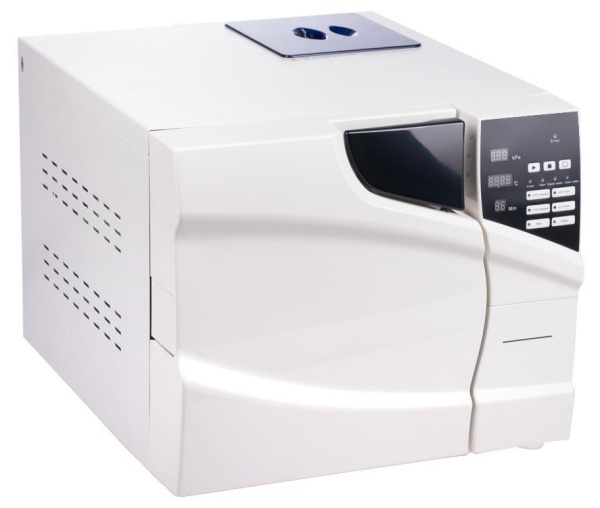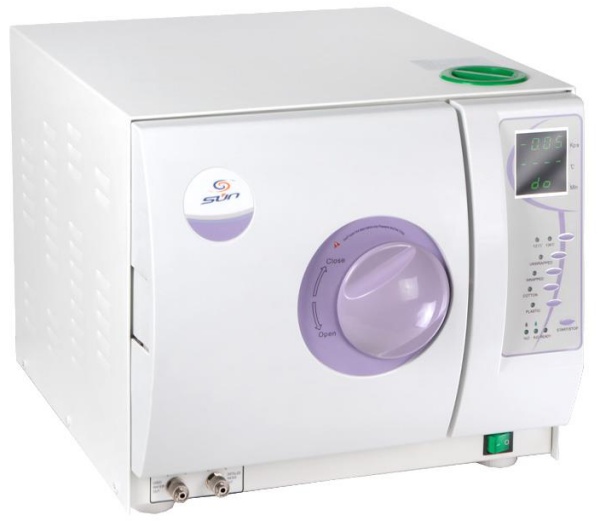Autoclave - what is this device, how does it work, how to classify them?

Autoclave is a device designed to sterilize various reusable tools. It is one of the most commonly used methods of sterilization. It is a hermetically sealed, heated tank in which physical processes take place. Inside its chamber, high pressure and temperature are maintained, thanks to which it increases the effectiveness of sterilization, does not cause corrosion or show toxicity. Thanks to the condensation of water vapor, energy is released, which leads to the complete destruction of dangerous microorganisms. the thigh of the autoclave allows you to carry out the sterilization process using high pressure and steam, thanks to which microorganisms such as viruses, bacteria, fungi and all their spore forms are killed.
The autoclave is a mandatory piece of equipment for dental and medical offices, and is also used in places where procedures are performed, wherever there is or may be to break the continuity of the skin, e.g. in hairdressers, beauty salons and tattoo studios. Reusable metal tools can be sterilized in it, and masks, bandages and other hygiene and dressing products can be sterilized before disposal.
With the development of technology, autoclaves are becoming smaller, faster and easier to use. The price also becomes more attractive, making them more available on the market. Autoclaves should be an essential element of the equipment of every office, where the basis is the safety and hygiene of the staff as well as all their clients and patients who are undergoing treatments that may break the continuity of the skin when using reusable tools
Sterilization
By definition, sterilization is a process during which all forms of microorganisms along with their spore forms are destroyed. Only tools that have undergone the sterilization process are completely safe for the human body.

The sterilization process has several stages:
Instruments should first be disinfected, washed under running water, dried and then packed in sterilization packages.
Proper sterilization should not damage or change the properties of sterilized items.
Sanepid requirements and autoclaves
The requirements of the Chief Sanitary Inspector regarding the possession of a tool sterilization device are imposed not only on medical and dental offices, but also on beauty salons, tattoo and piercing salons. These are the places where the continuity of the skin can be broken, which can lead to infection with viruses, bacteria and fungi.
Unsterile tools are a serious threat to the health and life of patients and customers of the aforementioned service places. Lack of sterilization of tools is a violation of the law, and the owner of the facility should take into account the unpleasant consequences (ACT ON THE PREVENTION AND COMBAT OF INFECTIONS AND INFECTIOUS DISEASES IN HUMANS OF DECEMBER 5, 2008 - a provision on the need to sterilize tools that may break the continuity of the skin). During the procedures, the continuity of tissues is disturbed, which poses a potential risk of infection with many diseases.
Types of infections:
- Viral infections: herpes simplex, skin warts, hepatitis B (HBV) and C (HCV) viruses and HIV
- Bacterial infections mainly staphylococci and streptococci
- Fungal infections include dermatophytes, yeasts and molds
- Parasitic infections
Tools undergoing sterilization processes:
- Beauty salons: pliers, scissors, tweezers, hooves, reusable nail files
- Hair salons: scissors, razors, reusable tools
- Tattoo, piercing parlors: all reusable tools such as piercing pliers, tubes, earrings, jewelry, tattoo grips and beaks
- Dental offices: impression trays, surgical instruments, contra-angles, handpieces
- Aesthetic medicine clinic: all reusable tools
- Podiatry room: scissors, pliers, hooves
- Veterinary offices: reusable tools, pincers, clippers, scissors, scalpels
Types of classes
There are three basic classes of autoclaves on the market, depending on their purpose, i.e. tools and products that can be sterilized in them.
Class N autoclave
The lowest class of sterilizers, it is mainly used to sterilize simple materials, such as solid, unpackaged loads. This device does not have a vacuum pump in the autoclave and will not ensure safety when sterilizing hollow loads, wrapped, porous instruments. Packed sterilization is not possible. By the regulations of 2004, it was declassified as an auxiliary unit.
Class S autoclave
This is an intermediate class between class N and class B. It is possible to sterilize most instruments, except those with a capillary structure. Class S enables the sterilization of objects with a more complex structure, single-packaged, multi-layered devices and massive tools that cannot be sterilized in class N. These autoclaves have a vacuum pump, it is possible to completely remove the air from the chamber, but this process is less effective than in autoclaves class B. Most often, class S is used in medical facilities where complex, recessed tools are not used, for example in primary care practices, as well as hairdressing salons, beauty salons and tattoo studios. In S autoclaves there may also be liquid sterilization options, which has its application in microbiology laboratories.
Class B autoclave
This is a top-class device, also called medical autoclaves. They can sterilize all types of instruments and medical devices, those packed, unpackaged, with a complex structure, solid loads, small porous items, full porous loads, simple hollow items, items with a narrow opening, multiple packaging that can be unwrapped or wrapped.
These autoclaves are the only ones equipped with a fractional pre-vacuum, thanks to which there is complete removal of air and free penetration of steam. They are also equipped with USB ports or memory cards, which enables archiving of ongoing processes in electronic form.
Tylko w tych autoklawach skutecznie wysterylizowane zostaną takie narzędzia jak cewniki, wzierniki, igły oraz końcówki stomatologiczne. Swoim zainteresowaniem mogą się cieszyć w takich miejscach jak praktyki dentystyczne, gabinety podstawowej opieki zdrowotnej, gabinetach kosmetycznych, i odnowy biologicznej oraz w praktykach weterynaryjnych, studiach tatuażu, kolczykowania i w salonach fryzjerskich.

Medical Autoclave
Medical autoclave one of the most advanced steam-pressure sterilizers. Suitable for sterilizing virtually any type of material.
The autoclaves have an LCD display which makes the autoclave look modern and stylish.
The volume of the autoclave starts from 8 liters to 23 liters. Thanks to this, it is able to accommodate many tools and packages within one sterilization process.
Technical passport in the set with the autoclave you will additionally receive a technical passport with a zero inspection of the device
from 3995 gross

